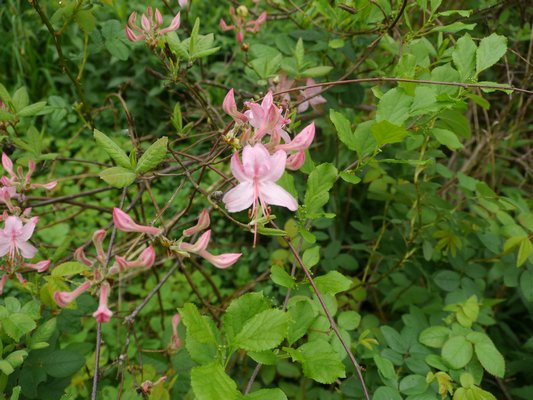

Azaleas are one of the most widely grown of our flowering shrubs, and many homes built in the last 60 or so years have the obligatory azalea foundation planting, or they were bunched along a walk or driveway, or clustered around a dogwood.All too frequently, however, the enjoyment of this group of plants is severely limited by a lack of knowledge on the part of both the homeowner and the landscape designer or architect. More often than not, the plant form and foliage may display a somewhat monotonous uniformity, or the growth and vigor of the plants is far less than satisfactory as the shrub suffers a slow death that lasts years.
These limitations are absolutely unnecessary. For disbelievers, a visit to the Planting Fields Arboretum in Oyster Bay during May should prove enlightening and exciting. Azaleas exist in a magnificent variety of colors and form and are really not difficult to grow.
In fact, the plants live for an astonishingly long time and come in a wide range of colors (some intense and brilliant, while others are soft and delicate), answering different landscape needs with varied growth habits and flower types, and providing a great range of blooming times, from early spring through the summer.
And, yes, for those of you who enjoy planting natives, there is an azalea that is native to Long Island, though it’s somewhat rare now. It’s called a pinxter or pinxter azalea (Rhododendron periclymenoides), and while its flowers are pale and unspectacular, the plant can still be striking in a wild or natural setting, and it’s incredibly hardy. It was once widely distributed in Long Island’s forested areas, but out here the deer have pretty much decimated it. Some nurseries still carry it, though.
As all cacti are succulents but not all succulents are cacti, all azaleas are rhododendrons but not all rhododendrons are azaleas. Rhododendrons (and, thus, azaleas) are members of the heath family, which also includes such plants as mountain laurel, heather, blueberry and others that are characterized by having bell-shaped flowers with the open end being lobed or petal-like, and all require an acid soil—and thus they love our East End gardens and woods.
These plants are native to both North America and Asia, with more than 20 species being native to the Appalachian chain from Maine to Texas. In fact, I was very surprised several years ago when visiting Northern Florida in late February: I was in a botanical garden that was just bursting with blooming azaleas—something few of us would associate with Florida.
All of our native azaleas are deciduous, but many of the Asian varieties (from Japan, China and Korea) include both evergreen and deciduous varieties.
All of these plants are essentially shrubs, although a few varieties grow to be small trees in the wild. Deciduous varieties tend to be upright growing, spreading with age, while most evergreen azaleas tend to be medium to low growing, rather dense and twiggy.
There are, however, numerous exceptions. Flower forms are extremely varied. Typically, the flowers have five petals, with the lower portions fused to form a tube, and the upper portions separated but overlapping. But, again, there are many variations on this theme. Some have narrow, deeply cut lobes, others broad ones, often frilled. Many are double, or semi-double, while others have a hose-in-hose form, in which the sepals have been transformed into petals, so that the flower appears to have two rings of petals, one arising from within the other.
The earliest evergreen azaleas were only marginally hardy. Discovered in south coastal Japan, Korea and China, they did not do well in this country but flourished in Europe late in the 19th century. In 1915, a Japanese nurseryman began introducing some hardier varieties, and Americans began to see the range of evergreen azaleas spread from the mid-South farther into the Northeast, to the point where locally we can now find hardy evergreens that are characterized by a wide range of flower form and colors.
The growth habits of the evergreens are almost as variable as their flowers. Some reach a size rivaling many rhododendrons, while others may not achieve more than a foot in height. The taller ones will have an open growth with a rather airy appearance, while the smaller ones will be dense and twiggy cushions. Most are characterized by having “dimorphic” leaves; that is, the first leaves that appear in the spring are deciduous, larger and thinner than the later leaves, which are evergreen and clustered near the ends of the twigs.
At the present time, there appear to be close to 80 evergreen azaleas available in our area whose flower colors range from white to orange, red, salmon and pinks, with blooming times beginning as early as April and continuing through mid-June.
The deciduous azaleas have long been favorites in Europe but have been strangely neglected here. Now, we now find their popularity growing rapidly. Among their great merits is a hardiness that permits them to flourish in many of our coldest spots that may be inhospitable to the evergreens.
The deciduous types bear large flowers in a wide range of colors: reds, pinks and whites, as well as the oranges and yellows that are hard to come by in the evergreens. Many are also delightfully fragrant. The attractive reds, yellows and purple-browns of their autumn leaves, and in some cases the interesting color of their spring growth, are some compensation for their spotty winter bareness.
Derived from native North America and Asia species, these plants have been developed by a century and a half of hybridizing into the magnificent garden varieties found today. The number of named varieties goes into the hundreds, but they do, as do the evergreens, fall into a small number of groups whose characteristic are sufficiently uniform to make a knowledge of them useful in selecting plants.
You may read about or see azaleas that claim to be re-bloomers or continuous bloomers. Be very skeptical. To date, I haven’t found any that reliably fit the description, at least not in our hardiness zones.
As I’ve noted so many times in the past, we are extraordinarily fortunate to have some of the finest nurseries and garden centers in the country on the East End, and the better ones have wonderful selections of azaleas for sale. Some are locally grown, while others are trucked in from as far away as Washington and Oregon—but they remain perfectly hardy.
While they easily can be planted in the fall or spring, you’ll find most varieties for sale now, and you can find a much wider selection if you are willing to search online and in catalogs. But, here, patience is a true virtue, as the plants you get by UPS or FedEx will be small and in need of growing time.
Once established, all azaleas respond well to a good soaking every couple of weeks during our dry summers, and they also respond well to applications of an acidic fertilizer like the organic Holly-tone when it’s applied in early spring and once again in early summer.
They are relatively insect- and disease-free but should not be subjected to overhead irrigation. In periods of summer drought, it’s not only important to water them occasionally but to watch the foliage for signs of spider mites. If you do spot the mites early, there is no need for insecticides. Simply use a spray nozzle on the end of your hose and, every few days for a couple of weeks, spray down the foliage, being careful to get the undersides, where the mites tend to populate. This spraying should be done in the morning, so the moisture doesn’t sit on the foliage at night.
Deer can be a big problem, but there are good and effective solutions including winter netting and repellents.
Now’s the time to check out the varieties at local garden centers (being careful of “bargains” that seem too cheap to be true) and to plan a trip to the Planting Fields Arboretum in Oyster Bay to see these plants in full glory.
Keep growing!
 More Posts from Andrew Messinger
More Posts from Andrew Messinger